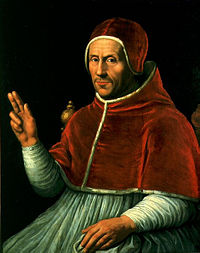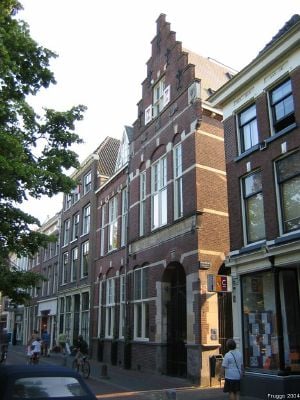Pope Adrian VI
| Adrian VI | |
|---|---|

| |
| Birth name | Adriaan Florenszoon Boeyens |
| Papacy began | January 9, 1522 |
| Papacy ended | September 14, 1523 |
| Predecessor | Leo X |
| Successor | Clement VII |
| Born | March 2 1459 Utrecht, Holy Roman Empire |
| Died | September 14 1523 (aged 64) Rome, Papal States |
| Other popes named Adrian | |
Pope Adrian VI (Utrecht, March 2, 1459 – September 14, 1523), born Adriaan Florenszoon Boeyens, served as Bishop of Rome from January 9, 1522 until his death some 18 months later. The only Dutchman to become pope, he was the last non-Italian pope until John Paul II, 456 years later.
Adrian VI was known for having attempted to launch a Catholic Reformation (or counter reformation) as a response to the Protestant Reformation. His efforts were fruitless as they were ignored by most of his Renaissance ecclesiastical contemporaries and his tenure as pope was too brief to make a lasting impression.
Early life
Adrian IV was born Adriaan Florisz Boeyens under modest circumstances in the city of Utrecht, which was then the capital of the bishopric of Utrecht, the Netherlands. Utrecht was at that time part of the Holy Roman Empire, which was largely populated by Germans was largely inhabited by Germans, and for this reason he is sometimes regarded as a German pope, although culturally and ethnically he was clearly a Dutchman.
Adrian was probably born in a house on the corner of the Brandsteeg and Oude Gracht that was owned by his grandfather Boudewijn (Boeyen for short). His father was Floris/Florens Boeyens van Utrecht, also born in Utrecht, and his mother's name was Gertruid. His father, a carpenter and likely shipwright, died when Adrian was 10 years or younger.
Adrian studied from a very young age under the Brethren of the Common Life, either at Zwolle or Deventer. He was also a student of the Latin school (now Gymnasium Celeanum) in Zwolle. In June 1476, he started his studies at the University of Louvain, where he pursued philosophy, theology and Canon Law, due to a scholarship granted by Margaret, Duchess of Burgundy. He earned a Doctor of theology in 1491, becamedean of St. Peter's church in Louvain, and later vice-chancellor of the university. His lectures were recreated and published from the notes of his students one of whom was the young Erasmus of Rotterdam.
Early career
In 1507 Adrian was appointed tutor to Emperor Maximilian I's (1493 – 1519) seven year old grandson, Charles, who was later to become Emperor Charles V (1519 – 56). In 1515 Adrian was sent to Spain on a diplomatic errand, and after his arrival at the imperial court in Toledo became bishop of Tortosa. November 14, 1516 was commissioned asInquisitor General of the kingdom of Aragon. The following year, Pope Leo X (1513 – 21) created Adrian a cardinal and gave him charge of the basilica of Saints John and Paul.
During the minority of Charles V, Adrian was named to serve with Francisco Cardinal Jimenez de Cisneros as co-regent of Spain. After the death of the Jimenez, Adrian was appointed (March 14, 1518) general of the unified Inquisitions of Castile and Aragon, in which capacity he acted until his departure for Rome.
After being elected emperor in 1519, Charles V left for the Netherlands in 1520 and appointed the future pope regent of Spain. During this time he had to deal with the Revolt of the Comuneros, which lasted nearly a year until the Battle of Villalar on April 23, 1521, after which the rebel leaders were beheaded.
Election as Bishop of Rome
After the death of the Medici Pope Leo X, his cousin, Cardinal Giulio de' Medici was the leading candidate to succeed him. However, with Spanish and French cardinals in a deadlock, the absent Adrian was proposed as a compromise candidate. He was thus elected pope on January 9, 1522 by an almost unanimous vote.
Charles V was delighted upon hearing that his old tutor had been elected to the papacy, but soon realized that Adrian VI was determined to reign impartially. Francis I of France, who feared that Adrian would become a tool of the emperor, and threatened a schism but soon relented and sent an embassy to present his homage. Adrian left Spain for Italy at the earliest opportunity, making his solemn entry into Rome on August 29, 1522. He was crowned in St. Peter's Basilica on August 31 at the age of 63.
After arrive in Rome, Adrian immediately instituted reforms with a very resistant papal court. He also had to contend with the Lutheran revolt in Germany, while at the same time dealing with the threat of the Turks, who already controlled Belgrade and now threatened Hungary.
Pope
Adrian's plan was to attack notorious abuses one by one, beginning with the practice of selling indulgences. In this attempt, however, he was hampered by his cardinals, who needed the money. He also found that reducing the number of dispensations to divorce and remarry was impossible as the income from these had been already advanced Pope Leo X by local authorities.
The Italian nobility, meanwhile, tended to view Adrian a pedantic foreign professor and even as a bit of a barbarian who was blind to the beauty of classical antiquity. Musicians such as Carpentras, the composer and singer from Avignon who was master of the papal chapel under Leo X, left Rome due to Adrian VI's indifference to the arts.
Adrian was also unsuccessful as a peacemaker among Christian princes, whom he hoped to unite in a war against the Turks. In August 1523, he was forced into an alliance with the Empire, England, and Venice against France. Meanwhile, in 1522 the Sultan Suleiman I (1520 – 66) had conquered Rhodes, a strategic gateway to .
In his reaction to the early stages of the Lutheran revolt, Adrian VI did not completely understand the gravity of the situation. At the Diet of Nuremberg which opened in December 1522 he was represented by Francesco Chiericati, whose private instructions contain the frank admission that the disorder of the Church was perhaps the fault of the Roman Curia itself, and that it should be reformed. However, the former professor and Inquisitor General was strongly opposed to any change in doctrinal, and demanded that Luther be punished for teaching heresy.
The statement in one of his works that a pope may err, privately or in a minor decree, including matters of faith, attracted attention. Catholics claim that it was a private opinion, not an official pronouncement and therefore does not conflict with the dogma of papal infallibility. Catholic apologists point to the fact that Adrian VI merely theoreticised about the issue.
Death
Adrian VI died on 14 September 1523, after a somewhat brief tenure. Most of his official papers were lost after his death. He published Quaestiones in quartum sententiarum praesertim circa sacramenta (Paris, 1512, 1516, 1518, 1537; Rome, 1522), and Quaestiones quodlibeticae XII. (1st ed., Leuven, 1515).
Italian writer Luigi Malerba used the confusion among the leaders of the Catholic Church, which was created by Adrian's unexpected election, as backdrop for his 1995 novel, Le maschere (The Masks), about the struggle between two Roman cardinals for a well-endowed church office.
See also
- Pasquinade
- The Tragical History of Doctor Faustus
Notes
ReferencesISBN links support NWE through referral fees
- Luther Martin. Luther's Correspondence and Other Contemporary Letters, 2 vols., tr.and ed. by Preserved Smith, Charles Michael Jacobs, The Lutheran Publication Society, Philadelphia, Pa. 1913, 1918. vol.I (1507-1521) and vol.2 (1521-1530) from Google Books. Reprint of Vol.1, Wipf & Stock Publishers (March 2006). ISBN 1-59752-601-0
- Gross, Ernie. This Day In Religion. New York:Neal-Schuman Publishers, Inc, 1990. ISBN 1-55570-045-4.
- Malerba Luigi. e maschere, Milan: A. Mondadori, 1995. ISBN 88-04-39366-1
External links
- Pope Adrian VI Catholic Encyclopedia
- Pope Adrian VI to Francesco Chieregati, Nov. 25, 1522[1] Re: Luther, corruption in the Catholic Church, the need for reform, etc.
- This article incorporates text from the Encyclopædia Britannica Eleventh Edition, a publication now in the public domain.
| Roman Catholic Popes | ||
|---|---|---|
| Preceded by: Leo X |
Pope 1522–23 |
Succeeded by: Clement VII |
| ||||||||||||||||
| |||||||||||||||||||||||||||||||||||||||||||||
| |||||||||||||||||||||||||||||||||||||||||
Credits
New World Encyclopedia writers and editors rewrote and completed the Wikipedia article in accordance with New World Encyclopedia standards. This article abides by terms of the Creative Commons CC-by-sa 3.0 License (CC-by-sa), which may be used and disseminated with proper attribution. Credit is due under the terms of this license that can reference both the New World Encyclopedia contributors and the selfless volunteer contributors of the Wikimedia Foundation. To cite this article click here for a list of acceptable citing formats.The history of earlier contributions by wikipedians is accessible to researchers here:
The history of this article since it was imported to New World Encyclopedia:
Note: Some restrictions may apply to use of individual images which are separately licensed.



